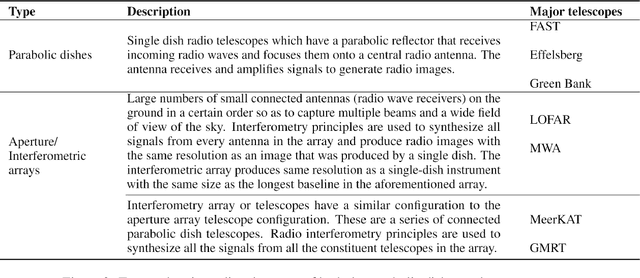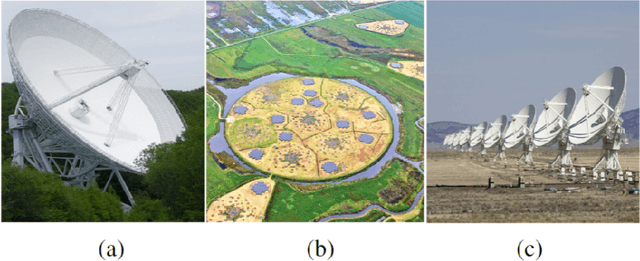Trienko Grobler
Anomaly detection in radio galaxy data with trainable COSFIRE filters
May 24, 2025Abstract:Detecting anomalies in radio astronomy is challenging due to the vast amounts of data and the rarity of labeled anomalous examples. Addressing this challenge requires efficient methods capable of identifying unusual radio galaxy morphologies without relying on extensive supervision. This work introduces an innovative approach to anomaly detection based on morphological characteristics of the radio sources using trainable COSFIRE (Combination of Shifted Filter Responses) filters as an efficient alternative to complex deep learning methods. The framework integrates COSFIRE descriptors with an unsupervised Local Outlier Factor (LOF) algorithm to identify unusual radio galaxy morphologies. Evaluations on a radio galaxy benchmark data set demonstrate strong performance, with the COSFIRE-based approach achieving a geometric mean (G-Mean) score of 79%, surpassing the 77% achieved by a computationally intensive deep learning autoencoder. By characterizing normal patterns and detecting deviations, this semi-supervised methodology overcomes the need for anomalous examples in the training set, a major limitation of traditional supervised methods. This approach shows promise for next-generation radio telescopes, where fast processing and the ability to discover unknown phenomena are crucial.
Classification of Radio Galaxies with trainable COSFIRE filters
Nov 19, 2023



Abstract:Radio galaxies exhibit a rich diversity of characteristics and emit radio emissions through a variety of radiation mechanisms, making their classification into distinct types based on morphology a complex challenge. To address this challenge effectively, we introduce an innovative approach for radio galaxy classification using COSFIRE filters. These filters possess the ability to adapt to both the shape and orientation of prototype patterns within images. The COSFIRE approach is explainable, learning-free, rotation-tolerant, efficient, and does not require a huge training set. To assess the efficacy of our method, we conducted experiments on a benchmark radio galaxy data set comprising of 1180 training samples and 404 test samples. Notably, our approach achieved an average accuracy rate of 93.36\%. This achievement outperforms contemporary deep learning models, and it is the best result ever achieved on this data set. Additionally, COSFIRE filters offer better computational performance, $\sim$20$\times$ fewer operations than the DenseNet-based competing method (when comparing at the same accuracy). Our findings underscore the effectiveness of the COSFIRE filter-based approach in addressing the complexities associated with radio galaxy classification. This research contributes to advancing the field by offering a robust solution that transcends the orientation challenges intrinsic to radio galaxy observations. Our method is versatile in that it is applicable to various image classification approaches.
Deep supervised hashing for fast retrieval of radio image cubes
Sep 02, 2023Abstract:The shear number of sources that will be detected by next-generation radio surveys will be astronomical, which will result in serendipitous discoveries. Data-dependent deep hashing algorithms have been shown to be efficient at image retrieval tasks in the fields of computer vision and multimedia. However, there are limited applications of these methodologies in the field of astronomy. In this work, we utilize deep hashing to rapidly search for similar images in a large database. The experiment uses a balanced dataset of 2708 samples consisting of four classes: Compact, FRI, FRII, and Bent. The performance of the method was evaluated using the mean average precision (mAP) metric where a precision of 88.5\% was achieved. The experimental results demonstrate the capability to search and retrieve similar radio images efficiently and at scale. The retrieval is based on the Hamming distance between the binary hash of the query image and those of the reference images in the database.
Advances on the classification of radio image cubes
May 05, 2023



Abstract:Modern radio telescopes will daily generate data sets on the scale of exabytes for systems like the Square Kilometre Array (SKA). Massive data sets are a source of unknown and rare astrophysical phenomena that lead to discoveries. Nonetheless, this is only plausible with the exploitation of intensive machine intelligence to complement human-aided and traditional statistical techniques. Recently, there has been a surge in scientific publications focusing on the use of artificial intelligence in radio astronomy, addressing challenges such as source extraction, morphological classification, and anomaly detection. This study presents a succinct, but comprehensive review of the application of machine intelligence techniques on radio images with emphasis on the morphological classification of radio galaxies. It aims to present a detailed synthesis of the relevant papers summarizing the literature based on data complexity, data pre-processing, and methodological novelty in radio astronomy. The rapid advancement and application of computer intelligence in radio astronomy has resulted in a revolution and a new paradigm shift in the automation of daunting data processes. However, the optimal exploitation of artificial intelligence in radio astronomy, calls for continued collaborative efforts in the creation of annotated data sets. Additionally, in order to quickly locate radio galaxies with similar or dissimilar physical characteristics, it is necessary to index the identified radio sources. Nonetheless, this issue has not been adequately addressed in the literature, making it an open area for further study.
 Add to Chrome
Add to Chrome Add to Firefox
Add to Firefox Add to Edge
Add to Edge